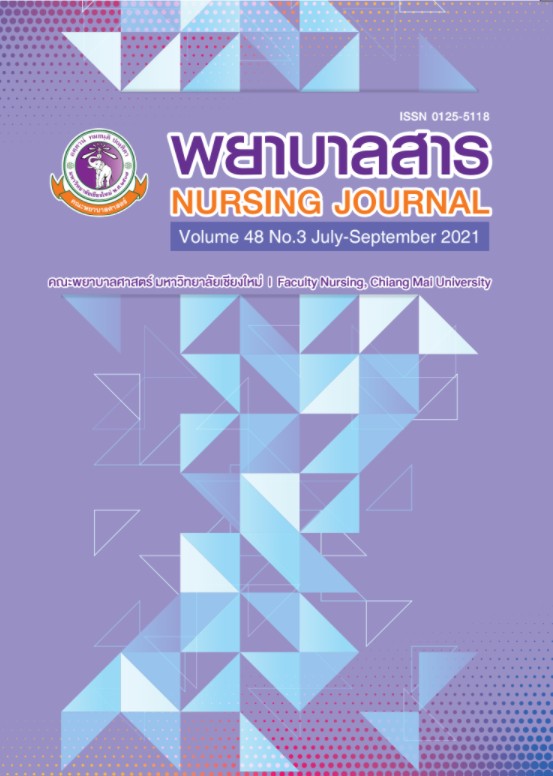ความต้องการในการจำหน่ายจากโรงพยาบาล: มุมมองของผู้ป่วยมะเร็งตับและท่อน้ำดีที่ได้รับการใส่สายระบายผ่านผิวหนังและเนื้อตับเข้าสู่ท่อน้ำดีและญาติผู้ดูแล
คำสำคัญ:
ความต้องการ, การจำหน่ายจากโรงพยาบาล, ผู้ป่วยมะเร็งตับและท่อน้ำดี, ญาติผู้ดูแลบทคัดย่อ
การรับรู้ความต้องการของผู้ป่วยมะเร็งตับและท่อน้ำดีที่ได้รับการใส่สายระบายผ่านผิวหนังและเนื้อตับเข้าสู่ท่อน้ำดีและญาติผู้ดูแลเกี่ยวกับการจำหน่ายจากโรงพยาบาลเป็นข้อมูลที่สำคัญสำหรับการวางแผนการจำหน่ายการจำหน่ายจากโรงพยาบาล การศึกษาครั้งนี้เป็นการวิจัยเชิงคุณภาพเพื่ออธิบายถึงความต้องการในการจำหน่ายจากโรงพยาบาลในมุมมองของผู้ป่วยมะเร็งตับและท่อน้ำดีที่ได้รับการใส่สายระบายผ่านผิวหนังและญาติผู้ดูแล ผู้ให้ข้อมูลเป็นผู้ป่วยมะเร็งตับและท่อน้ำดีที่ได้รับการใส่สายระบายผ่านผิวหนังและญาติผู้ดูแล คัดเลือกแบบเฉพาะเจาะจง จำนวน 20 ราย เก็บรวบรวมข้อมูลโดยใช้การสัมภาษณ์เชิงลึก วิเคราะห์ข้อมูลโดยการวิเคราะห์แก่นสาระ
ผลการวิจัยพบว่าความต้องการในการจำหน่ายจากโรงพยาบาลของผู้ป่วยมะเร็งตับและท่อน้ำดีที่ได้รับการใส่สายระบายผ่านผิวหนังและญาติผู้ดูแล มี 4 ประเด็น ได้แก่ 1) ความพร้อมด้านร่างกายของผู้ป่วย 2) ความรู้ในการดูแลตนเองและดูแลผู้ป่วยเมื่อกลับไปอยู่ที่บ้าน 3) การดำเนินการสอนก่อนกลับบ้านที่เหมาะสม และ 4) การสนับสนุนในการดูแลผู้ป่วยที่บ้าน จากผลการศึกษาทำให้มีความเข้าใจเกี่ยวกับความต้องการในการจำหน่ายจากโรงพยาบาลของผู้ป่วยมะเร็งตับและท่อน้ำดีที่ได้รับการใส่สายระบายผ่านผิวหนังและญาติผู้ดูแล และสามารถนำไปเป็นแนวทางในการวางแผนการจำหน่ายจากโรงพยาบาลที่เหมาะสมต่อไป
เอกสารอ้างอิง
Auerbach, A. D., Kripalani, S., Vasilevskis, E. E., Sehgal, N., Lindenauer, P. K., Metlay, J. P., . . . & Schnipper, J. L. (2016). Preventability and causes of readmissions in a national cohort of general medicine patients. JAMA Internal Medicine, 176(4), 484-493. doi:10.1001/jamainternmed.2015.7863
Bergman, K., & Louis, S. (2016). Discharge instructions for concussion: Are we meeting the patient Needs? Journal of Trauma Nursing, 23(6), 327-333. doi:10.1097/jtn.0000000000000242
Braun, V., & Clarke, V. (2006). Using thematic analysis in psychology. Qualitative Research in Psychology,3(2), 77-101.
Cancer Registry Unit, Medical Digital Division, National Cancer Institute. (2020). Hospital Based Cancer Registry 2019. Bangkok: New Thammada Press.
Chen, J., Zhu, X., Jiang, J., Qi, Y., & Shi, Y. (2019). Needs of Chinese patients undergoing home-based rehabilitation after hip replacement: A qualitative study. PLoS One, 14(7), e0220304. doi:10.1371/journal.pone.0220304
Cohen, S., Gottlieb, B. H., & Underwood, L. G. (2000). Social relationships and health. In S. Cohen, L. G. Underwood, & B. H. Gottlieb (Eds.), Social support measurement and intervention: A guide for health and social scientists. New York: Oxford University Press.
Farahani, M. A., Bahloli, S., JamshidiOrak, R., & Ghaffari, F. (2020). Investigating the needs of family caregivers of older stroke patients: A longitudinal study in Iran. BMC Geriatrics, 20 (1), 313. doi:10.1186/s12877-020-01670-0
Hesselink, G., Flink, M., Olsson, M., Barach, P., Dudzik-Urbaniak, E., Orrego, C., . . . & Wollersheim, H. (2012). Are patients discharged with care? A qualitative study of perceptions and experiences of patients, family members and care providers. BMJ Quality & Safety, 21 (Suppl 1), i39-49. doi:10.1136/bmjqs-2012-001165
Khammanee, T. (2017). Instructional curriculum: Knowledge for effective learning process.
Bangkok: Dansutha Press.
Kreutzer, J. S., Marwitz, J. H., Klyce, D. W., Wilder Schaaf, K. P., Sima, A. P., Welch, A. M., & Niemeier, J. P. (2018). Family needs on an inpatient brain injury rehabilitation unit: A quantitative assessment. Journal of Head Trauma Rehabilitation, 33(4), 228-236. doi:10.1097/htr.0000000000000390
Kreutzer, J.,Serio ,C., & Bergquist, S. (1994). Family needs following traumatic brain injury: A quantitative analysis. Journal of Head Trauma Rehabilitation, 9(1), 104-115.
Likitkentasorn, S., Thanassilp, S., & Pudtong, N. (2018). Selected factors factors associated with supportive care needs in person with liver and intrahepatic bile duct cancer. Kuakarun Journal of Nursing, 25(1), 170-183. (in Thai)
Lincoln, Y.S., & Guba, E.G. (1985). Naturalistic inquiry. Newbury Park: SAGE.
Medical record and statistics unit, Faculty of Medicine Chiang Mai University. (2016 - 2020).In patients statistics 2016 - 2020. Chiang Mai: Chiang Mai Universities. (In Thai)
Norup, A., Perrin, P. B., Cuberos-Urbano, G., Anke, A., Andelic, N., Doyle, S. T., . . . Carlos Arango-Lasprilla, J. (2015). Family needs after brain injury: A cross cultural study. NeuroRehabilitation, 36(2), 203-214. doi:10.3233/nre-151208
Nurhayati, N., Songwathana, P., & Vachprasit, R. (2019). Surgical patients’ experiences of readiness for hospital discharge and perceived quality of discharge teaching in acute care hospitals. Journal of clinical nursing, 28(10), 1728-1736.
Orem, D. (1985). Nursing: Concept of practice. (3rd ed). New York: McGraw Hill Box.
Pomrod, T., Monkong, S., & Sirapo-ngam, Y. (2011). Responses to needs and coping to stress of patients’ relatives before transferring from the intensive care unit. Region 11 Medical Journal, 17(1), 75-89. (in Thai)
Punyagariyagorn, S. (2013). Factors related to preventive sehaviors affecting complications of cholangiocarcinoma’s patients after percutaneous transhepatic biliary drainage. Nursing Journal of Ministry of Public Health, 23(1) : 70–79. (in Thai)
Sanprasan, P., Wattradul, D., & Suthipong, N. (2017). Discharge planning of patients treated with percutaneous coronary intervention (PCI): Perspective of elderly patients with ischemic heart disease and caregivers. Thai Journal of Cardio-Thoracic Nursing, 28(1), 142–153. (in Thai)
Sarwar, A., Hostage, C. A., Jr., Weinstein, J. L., Kim, G., Novack, V., Chakrala, N., . . ., & Ahmed, M. (2019). Causes and rates of 30-day readmissions after percutaneous transhepatic biliary drainage procedure. Radiology, 290(3), 722-729. doi:10.1148/radiol.2018180279
Sha, J, Dong, Y & Niu, H. (2019). A prospective study of risk factors for in-hospital mortality in patients with malignant obstructive jaundice undergoing percutaneous biliary drainage. Medicine , 98(15), e15131.
Soebagiyo, H., Beni, K. N, & Fibriola, T. N. (2019). The analysis of the influencing factors related to the effectiveness of discharge planning implementation in hospitals: A systematic Review. Jurnal Ners, 14(3si), 217-220.
Srihabandit, W., Khimsungnen, N., & Namchanthra, R. (2018). Need of The Caregivers of Patients with Cerebrovascular disease. The 13th RSU National Graduate Research Conference. (in Thai)
Srisomphan, K., Sirisakulpaisarn, B. & Bormann, S.V. (2017). Peer-assisted learning strategy in return-demonstration exam for mechanism of labor. Journal of health science research, 11(2), 138-146. (in Thai).
Suamkhuntod, P., Deoisres, W & Wacharasin, C. (2018). Family members’ needs and needs responsiveness of patients during preoperative cataract surgery. The Journal of Faculty of Nursing Burapha University, 26(1), 29-39. (In Thai)
Tabootwon, w., & Jullamate, P. (2015). Needs and respond needs of elderly who received ventilator. The Journal of Faculty of Nursing Burapha University, 23(2), 52-62.
Thai Association for the Study of the Liver. (2016). Hepatocellular carcinoma. Nonthaburi: Parbpim Printing. (In Thai).
Titapun,A. (2015). Management in perihilar cholangiocarcinoma. Srinagarind Medical Journal, 30 (Suppl), 30 – 35. (In Thai)
Verhaegh, K. J., Jepma, P., Geerlings, S. E., de Rooij, S. E., & Buurman, B. M. (2019). Not feeling ready to go home: a qualitative analysis of chronically ill patients' perceptions on care transitions. International Journal of Quality in Health Care, 31(2), 125-132. doi:10.1093/intqhc/mzy139
Vichittragoonthavon, S., Imsa-njuan, K., & Sucamvang, K. (2013). Needs and received need responses among elderly patients and families in Surgical Intensive Care Unit, Maharaj Nakorn Chiang Mai Hospital. Nursing Journal, 40(special), 35-46. (In Thai)
Weiss, M., Yakusheva, O., & Bobay, K. (2010). Nurse and patient perceptions of discharge readiness in relation to postdischarge utilization. Medical Care, 48(5), 482-6.
Yura, H., & Walsh, M. B. (1988). The nursing process: Assessing, planning, implementation, evaluation. (5thed). Norwalk: Prentice Hall.
ดาวน์โหลด
เผยแพร่แล้ว
รูปแบบการอ้างอิง
ฉบับ
ประเภทบทความ
สัญญาอนุญาต
บทความที่ได้รับการตีพิมพ์เป็นลิขสิทธิ์ของวารสารพยาบาลสาร
ข้อความที่ปรากฏในบทความแต่ละเรื่องในวารสารวิชาการเล่มนี้เป็นความคิดเห็นส่วนตัวของผู้เขียนแต่ละท่านไม่เกี่ยวข้องกับมหาวิทยาลัยเชียงใหม่ และคณาจารย์ท่านอื่นๆในมหาวิทยาลัยฯ แต่อย่างใด ความรับผิดชอบองค์ประกอบทั้งหมดของบทความแต่ละเรื่องเป็นของผู้เขียนแต่ละท่าน หากมีความผิดพลาดใด ๆ ผู้เขียนแต่ละท่านจะรับผิดชอบบทความของตนเองแต่ผู้เดียว






